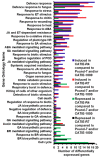Successful pod infections by Moniliophthora roreri result in differential Theobroma cacao gene expression depending on the clone's level of tolerance
- PMID: 24528440
- PMCID: PMC6638783
- DOI: 10.1111/mpp.12126
Successful pod infections by Moniliophthora roreri result in differential Theobroma cacao gene expression depending on the clone's level of tolerance
Erratum in
-
Corrigendum.Mol Plant Pathol. 2017 Jan;18(1):169. doi: 10.1111/mpp.12498. Mol Plant Pathol. 2017. PMID: 28000359 Free PMC article. No abstract available.
Abstract
An understanding of the tolerance mechanisms of Theobroma cacao used against Moniliophthora roreri, the causal agent of frosty pod rot, is important for the generation of stable disease-tolerant clones. A comparative view was obtained of transcript populations of infected pods from two susceptible and two tolerant clones using RNA sequence (RNA-Seq) analysis. A total of 3009 transcripts showed differential expression among clones. KEGG (Kyoto Encyclopedia of Genes and Genomes) pathway analysis of differentially expressed genes indicated shifts in 152 different metabolic pathways between the tolerant and susceptible clones. Real-time quantitative reverse transcription polymerase chain reaction (real-time qRT-PCR) analyses of 36 genes verified the differential expression. Regression analysis validated a uniform progression in gene expression in association with infection levels and fungal loads in the susceptible clones. Expression patterns observed in the susceptible clones diverged in tolerant clones, with many genes showing higher expression at a low level of infection and fungal load. Principal coordinate analyses of real-time qRT-PCR data separated the gene expression patterns between susceptible and tolerant clones for pods showing malformation. Although some genes were constitutively differentially expressed between clones, most results suggested that defence responses were induced at low fungal load in the tolerant clones. Several elicitor-responsive genes were highly expressed in tolerant clones, suggesting rapid recognition of the pathogen and induction of defence genes. Expression patterns suggested that the jasmonic acid-ethylene- and/or salicylic acid-mediated defence pathways were activated in the tolerant clones, being enhanced by reduced brassinosteroid (BR) biosynthesis and catabolic inactivation of both BR and abscisic acids. Finally, several genes associated with hypersensitive response-like cell death were also induced in tolerant clones.
Keywords: RNA-Seq; differential transcriptome; frosty pod rot; hemibiotroph; plant defence; tolerance.
© 2014 BSPP AND JOHN WILEY & SONS LTD.
Figures





References
-
- Ali, S.S. , Kumar, S. , Khan, M. and Doohan, F.M. (2013) Brassinosteroid enhances resistance to Fusarium diseases of barley. Phytopathology, 103, 1260–1267. - PubMed
-
- Anders, S. (2011) Analysing RNA‐Seq data with the ‘DESeq’ package. Available at: http://bioconductor.org/help/course‐materials/2011/BioC2011/LabStuff/DES... [accessed on April 29, 2013].
-
- Anderson, J.P. , Badruzsaufari, E. , Schenk, P.M. , Manners, J.M. , Desmond, O.J. , Ehlert, C. , Maclean, D.J. , Ebert, P.R. and Kazan, K. (2004) Antagonistic interaction between abscisic acid and jasmonate–ethylene signaling pathways modulates defense gene expression and disease resistance in Arabidopsis. Plant Cell, 16, 3460–3479. - PMC - PubMed
-
- Argout, X. , Salse, J. , Aury, J.M. , Guiltinan, M.J. , Droc, G. , Gouzy, J. , Allegre, M. , Chaparro, C. , Legavre, T. and Maximova, S. (2010) The genome of Theobroma cacao . Nat. Genet. 43, 101–108. - PubMed
Publication types
MeSH terms
Substances
Associated data
- Actions
LinkOut - more resources
Full Text Sources
Other Literature Sources

